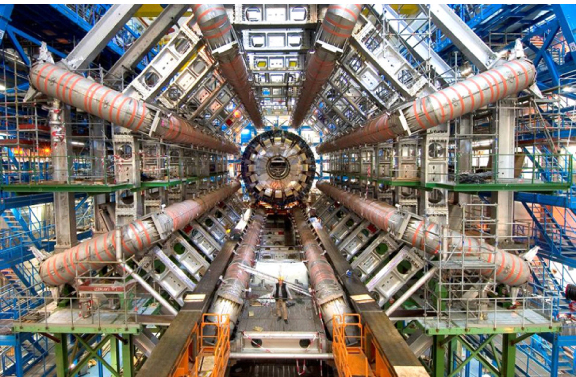Science writer Luke Slade explains the significance of the discovery of the infamous Higgs boson.
Over the summer, CERN physicists from the Large Hadron Collider (LHC) in Geneva have observed a particle with properties that are consistent with those of the elusive Higgs boson, marking the beginning of a new wave of scientific discovery.
Sometimes known as the ÔÇÿGod particleÔÇÖ, the Higgs boson has been at the centre of a search to understand how matter attains its mass for the best part of 45 years.
Speaking at the announcement conference in Geneva, the spokesperson for the CMS (Compact Muon Solenoid, one of the LHCÔÇÖs particle detectors), Prof Joe Incandela, told the assembled crowd : ÔÇ£The results are preliminary but the five-sigma signal at around 125 GeV we’re seeing is dramatic. This is indeed a new particle.ÔÇØ
But I shall leave out most of the heavy science (see what I did there?) in favour of answering plainly: what the bloody hell does Higgs want with a boson?
The first thing to get out of the way is talks of bosons and fields. In the early universe, all of the particles that occupied it had no mass. They would therefore move through space unrestricted and at the speed of light.
About a trillionth of a second after the Big Bang (it wasnÔÇÖt the early universe for very long you see) what we now call the Higgs field was ÔÇÿswitched onÔÇÖ. This field slowed different particles down by giving them mass. Essentially, it is like ÔÇÿdragÔÇÖ┬á but for particles, weighing different particles down and stopping them from moving freely at the speed of light. An exception, although not unique, is the photon, which remains massless.
Higgs bosons are the particles that make up the Higgs field. In order to detect them, however, we must recreate the conditions just after the Big Bang – enter the Large Hadron Collider. The LHC allows us to fire protons at each other, creating a relatively ÔÇÿbigÔÇÖ bang (but realistically, quite a small bang).
After the collision, all sorts of particles come out of a flash of energy, including electrons and quarks, but most importantly the Higgs boson. What makes the Higgs so elusive is that as soon as it is created and has done its job, it starts to decay into other particles, and they in turn, also decay.
And that is pretty much how it works and why it has taken so long to find anything close to the Higgs.
One question that may be surfacing, is why not just call it the Higgs boson, then?
What is all this talk about ÔÇÿconsistent withÔÇÖ and ÔÇÿaccording to the Standard ModelÔÇÖ for? To put it simply: it is because there are so many different decay patterns.
(IÔÇÖm going to get a tad more science-y now so you can skip to the concluding paragraph if you like)
When you have a Standard Model Higgs, it will choose randomly among the decay options it has. That said, it will still do so according to probabilities that are precisely predicted in the Standard Model. But then this is quantum physics and, at this level, individual events cannot simply be predicted.
The Higgs in the Standard Model, as I have mentioned above, is there to give particles their mass. Specifically, however, it is there to give mass to two distinct types of particle: bosons and fermions. The Higgs breaks the symmetry between two of the four fundamental forces of nature ÔÇô specifically, the weak and the electromagnetic forces – by giving the bosons carrying weak force mass, while leaving the photon, which carries the electromagnetic force, massless. For the Higgs to do this, it itself has to have a mass similar to that of the weak bosons. This is fundamentally at the heart of why physicists knew that, if the Higgs existed, they could find it with the LHC.
I shall not go into it further than that for fear of leaving my knowledge zone (which is limited in the world of science), but the whole thing does get more complicated and IÔÇÖm sure if youÔÇÖre interested then you can do some research into the world of fermions, quarks and neutrinos.
So, Higgs bosons make up a Higgs field that existed to give particles their mass. It therefore accounts for all unexplained mass in the universe. It doesnÔÇÖt disprove God, as the tabloids like to point out in their wonderfully original headlines. What it does do is lead us into a wonderful and exciting future of science and one that we are all living through.
ÔÇ£So basically the Higgs boson did to matter what divorce did to Betty DraperÔÇØ – @RonanFarrow
EditorÔÇÖs note ÔÇô For a particle physics discovery to be considered significant (i.e. not due to chance), the data needs to have a 5-sigma level of certainty. Since the time of writing, CERNÔÇÖs data has now reached 5.9-sigma of certainty, and is therefore more significant than previously thought.





Add Comment